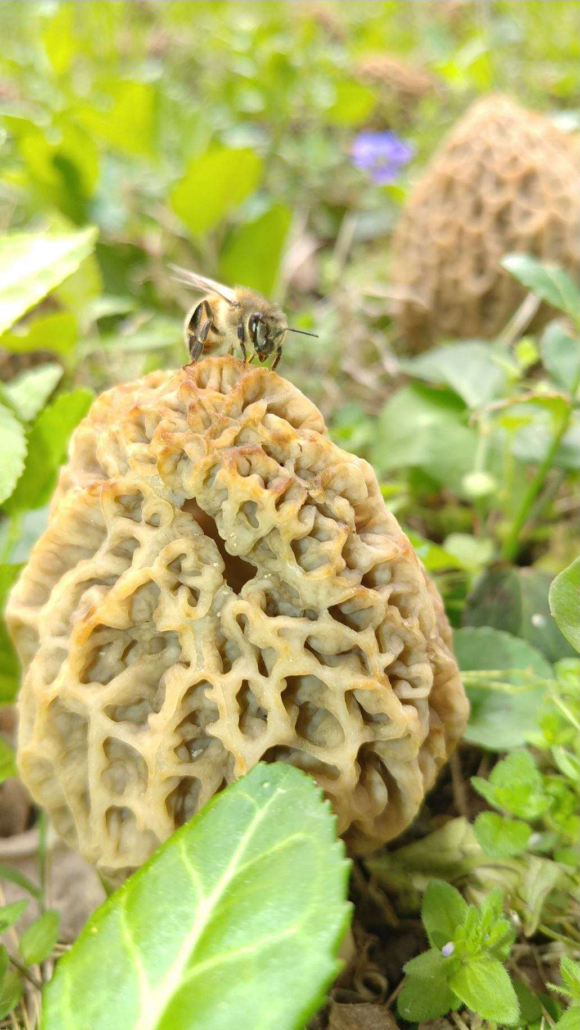Can You Grow Morels at Home?

By Claire Stuart
If you have ever eaten morels, you know why these odd-looking, wrinkled mushrooms are so sought after. They grow wild in our area, and they are only found at a certain time of year in certain habitats. Their locations are closely-guarded secrets kept by knowledgeable foragers, often for generations. But what if you could reliably grow morels in your own yard? Impossible, say the skeptics! It’s been tried, using all sorts of experimental methods, for years and years, with virtually no success. Morels simply grow where they want to grow.
Here in Clarke County, Nate and Carrie Fox of Riverfox Farm are surprising the skeptics. The Foxes operate a small Berryville farm where they raise bees, heritage poultry, and cut flowers. Carrie recalls that Nate, who had been a morel hunter for years, introduced her to morels when they were dating. “It was sort of a courtship gift,” she laughed. He had tried to grow his own over the years, using locally foraged mushrooms, but had been unsuccessful.
This year, the Foxes finally succeeded in producing a carpet of hundreds of precious morels. Dozens of participants in their two morel workshops in May had a chance to see morels growing — and taste them, too.
“In 2019, we tried a different method,” Carrie reported. “We used grain spawn and inoculated the soil with a mixture of local morels. In 2020, only about five or six mushrooms grew. Then, this year, hundreds suddenly appeared at night. We went down at night with headlamps and saw them! Over the next two weeks, they were emerging and spreading. It was so exciting! We wondered if we should keep it a secret, then we said, ‘No, let’s do a workshop. Let people see the area, the moisture of the soil, the light, and other conditions.’
”This year’s first workshop was held on May 1, and about 30 people participated. It was followed by another on May 15 with about 40 people, and all went home with jars of inoculated grain spawn. The Foxes are going to try to make it an annual event.
Carrie explained that their methods and timing are different from what most people try — making a slurry in a bucket with ashes, etc., and dumping it in the garden. While spores are very hardy, once you trigger growth, it is fussy. “We’re giving Mother Nature a hand. From our harvest, we use spores to prepare grain spawn jars. We don’t have a fancy lab; we work out of our home kitchen. We prepare jars in the pressure canner and buy grain at the Berryville feed store. People can do it in their own homes. The people at the first workshop could see mycelium growing in the grain spawn jars.
“We tend the jars through the hot summer—timing is so important. We plant in fall because they require a winter to produce in the spring. We prepare the bed site with things that saprophytic mushrooms enjoy: kitchen scraps, compost, dead leaves, wood shavings, and ashes from the wood stove. We dig a trench, put the mycelium in, water it well, and let it overwinter. The mycelium feeds off dead and decaying vegetable matter. Some morels have a mycorrhizal relationship with living trees and other plants for food.”
Carrie suspects that their beekeeping practices contributed to the successful growth of the morels.
“We noticed a relationship between the location of our apiary and where mushrooms popped out.” The Foxes have around 60 honey bee colonies. Carrie explained that when they need to supplement small colonies to build them up, they feed the bees a sugar-water mixture and a pollen patty supplement. Any excess sugar water and pollen that the bees don’t take is dumped around the tree line. Bees often build extra comb on top of or between the wooden frames, sometimes filling them with drone cells. Beekeepers must scrape it off to keep the frames clean, and these scrapings (high in proteins, fats and carbohydrates) are also dumped. The Foxes found morels popping up in those areas.Carrie hopes that their results will encourage further research and give potential morel growers a reason for optimism.
The Foxes are creating online content and instructions; a tutorial is in the works, and they are planning for a 2022 spring morel workshop. If you are thinking of beekeeping, have your first colony, need tips and pointers, or just want to learn about bees, visit their website for information about their hands-on honey bee days, starter colonies and queen bees for sale.
Visit them online at riverfoxfarm.com
Things to Know About Mushrooms:• Mushrooms are fungi and do not have chlorophyll, so they need to absorb food from their environment, and most do not need light to grow.• Saprophytic fungi grow on dead and decaying organic matter.• Mycorrhizal fungi have a symbiotic partnership with living green plants (usually trees), living in and around their roots and sharing nutrients.• Most of a mushroom is underground in the form of root-like mycelium, which is made of fibers called hyphae that absorb food. • The familiar mushrooms that we eat are the fruiting bodies of the fungus. The mycelium can stay dormant for years before sending up fruiting bodies. • Microscopic spores that serve as seeds are produced on gills under the mushroom’s cap. • Grain Spawn: Wheat, rye, millet, etc., is cooked with water and sterilized, and mycelium is added and will grow on the grain.• Substrate is the material the fungus will live and grow on, such as compost, dead wood, sawdust, rotting leaves, etc.• Inoculation is introducing spores or mycelium culture to a substrate.









